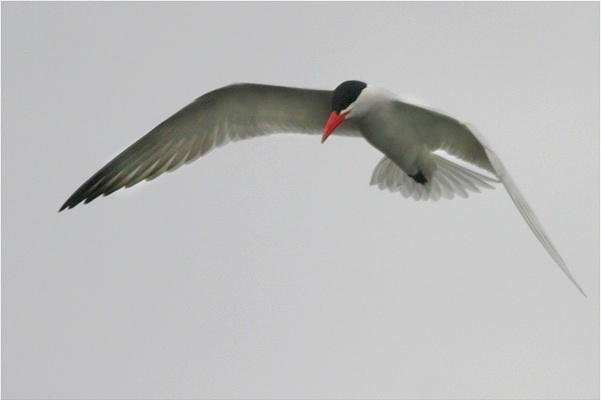
Location: Mission Trails Regional Park, San Diego, CA
Date: 2004-05-23
Lens: Canon 400mm F5.6

 Caspian Tern
Sterna caspia
Caspian Tern
Sterna caspia
 Description
DescriptionThe Caspian Tern is the largest tern in North America. Its slow, stiff flight makes it easily identifiable. This bird has an odd breeding distribution around North America, with isolated colonies in Utah, Wyoming, British Columbia, the Great Lakes area, and the Pacific coast, including San Diego. Caspians are more predatory than other terns, readily taking small birds or the eggs and young of other terns.
General: Sexes similar. Reaches full adult plumage after 3 years. 19 to 23 inches in length.
Adult Alternate: Pale gray back and upperwings. White face, neck, breast, belly, and short, forked tail. Black cap with short crest. Thick dark red-orange bill with weak, black dusting at the tip. Black legs. Pale underwings with a portion of the outer few primaries being dark gray-black.
Adult Basic: Similar to adult alternate, except it has a streaked black-and-white cap and darker primaries.
Juvenile: Similar to adult basic, except it has black scalloping on its back, a more orange bill, pale legs, a brownish-and-white streaked cap, grayish tail, and a portion of both the outer primaries and secondaries are dark gray-black. First-year birds similar to adult basic but have a pale forehead, darker uppersurfaces to the outer primaries, and dark secondaries. Second-year birds are similar to adult alternate but sometimes have white spots in the cap and some gray in the tail.
Lakes, rivers, beaches, and coastal waters.
 Nesting
Nesting2-3 buff eggs with spots. The incubation period is 20-22 days. Fledging occurs 30-40 days after hatching. Both parents help incubate the eggs and care for the young. The nest is a shallow ground depression or a well made cup of dead grass, usually built on a sandy or rocky island. Will nest in disturbed or human-created areas, such as dikes and shorelines. Nests by itself or in small colonies.